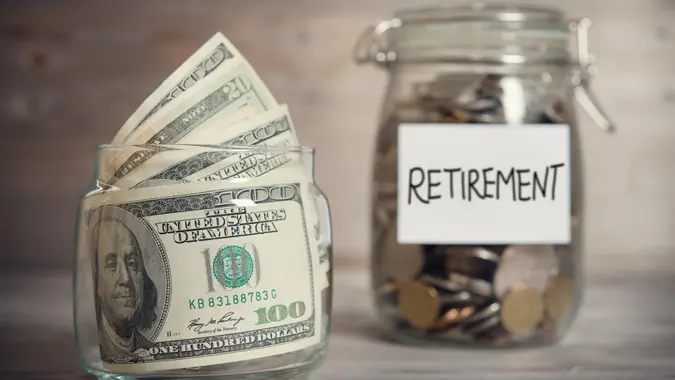‘Money Girl’ Laura Adams: 9 Retirement Tips for Different Goals and Budgets

Commitment to Our Readers
GOBankingRates' editorial team is committed to bringing you unbiased reviews and information. We use data-driven methodologies to evaluate financial products and services - our reviews and ratings are not influenced by advertisers. You can read more about our editorial guidelines and our products and services review methodology.

20 Years
Helping You Live Richer

Reviewed
by Experts

Trusted by
Millions of Readers
Depending on how close you are to retirement, you may be thinking more or less about planning for it. Yet, whether you’re 25 or 65, retirement planning is crucial to be able to put your working days behind you one day and not stress about money.
Laura Adams, host of the “Money Girl” podcast and founder of ‘The Money Stack’ newsletter, recently spoke with Jaime Catmull, host of GOBankingRates’ ‘Richer Way Podcast,’ about some retirement planning tips for different goals and budgets. Read on to find out more depending on your stage of retirement.
Every American Should Save This Much for Retirement
Financial experts toss around different amounts for how much you should have in retirement savings. Adams explained that retirement savings should, ideally, be a combination of your Social Security benefits, pension income, and any annuities you purchase. She said to get to that number, you need to factor in your retirement age, expected longevity and desired lifestyle.
However, assuming you have no retirement income other than your investments and believe you’ll live for 30 years, she recommended at least $1 million as a good goal.
“If you kept it growing in a balanced portfolio and withdrew 5% annually, you could take $50,000 in [annual] income. However, your annual income could increase if you delay retirement or qualify for Social Security retirement benefits.”
Americans Should Have This Much in Emergency Savings
For regular savings, this also depends on your income, debt, family situation and financial goals.
“However, a good plan is to maintain an emergency savings equal to at least three months’ worth of your living expenses. That would protect you from relying on debt in a hardship like losing your job or business income or having a significant, unexpected expense,” Adams said.
Consider Unconventional Savings Methods
While saving a lot of money can feel daunting, Adams said there are many ways to save that are unconventional and even fun.
“For instance, you might set a no-spend challenge where you avoid all discretionary purchases for a period, such as a day, week, or as long as you can. Or you might only spend on used items instead of purchasing new ones by going to the library, shopping online thrift stores, or swapping articles with family and friends.”
Have a Backup for Social Security
For people who think they can retire on only Social Security, Adams warned that this may be too risky since the average payment is about $1,800 a month, hardly enough for most people to live on.
“If you don’t have a workplace pension and cannot save for retirement, you may get forced to live on significantly less in your old age or become financially dependent on family or friends. Relocating to a less expensive city, state or country could be an option for those with minimal income in retirement,” she said.
Balance Different Types of Retirement Investments
Retirement advisors often recommend different investment vehicles, so how to choose? Adams said, “Your top priority should be maxing out one or more tax-advantaged retirement plans, such as a 401(k), IRA or self-employed account, yearly.”
She said if you still have more to invest, purchasing investment property, cash value life insurance, or alternative assets in a taxable brokerage could be great ways to diversify your retirement wealth.
Younger Generations Should Invest Differently
For younger investors who have a long horizon with many years to go before retirement, Adams recommended they invest primarily in diversified stock funds that offer higher returns.
“While they’re more volatile than more conservative investments, such as bonds, stock funds allow young people to outpace inflation and grow a sizable nest egg for a comfortable retirement.”
Be Careful With a FIRE Plan
The FIRE movement, short for “Financial Independence, Retire Early,” has taken off recently. It’s devoted to saving and investing aggressively so you can retire early or do optional work. Adams said, “While it’s a terrific goal, if you retire in your 30s or 40s, you may need income for 50 or more years, depending on your health and willingness to work in retirement.”
That means you may need a much larger nest egg than expected to ensure you never run out of money in retirement.
“In other words, you’ll likely need to earn more, spend less, or do both to invest enough to hit a FIRE savings target,” she cautioned.
Another downside of early retirement is that you are making significant financial sacrifices now so you can invest enough for your future desired lifestyle. “Also, you may feel disconnected if you don’t have other retired friends or family to spend time with,” said Adams.
How To Handle an Income Increase or Unexpected Windfall
If you are in the fortunate position to have an income increase or an unexpected influx of cash, Adams sees it as a powerful opportunity to improve your financial life.
“First, review your emergency savings. Recent data from Finder’s Consumer Confidence Index found that 17% would only be able to live off their savings for a week or less if they lost their job tomorrow.”
A good rule of thumb is to keep at least three to six months’ worth of living expenses in an FDIC-insured high-yield savings account. “If you really want to be prepared, bump that amount based on your and your family’s needs,” she said.
So, if you start making more money, also start or increase making regular contributions to tax-advantaged retirement accounts at work or on your own to simultaneously build wealth and cut taxes.
“Once you have a healthy cash cushion and are in the habit of investing for the future, focus on paying down your debt. Fewer liabilities can reduce money stress and help you live within your means if you tend to overspend,” Adams explained.
The Best Money Advice Everyone Should Take
Adams said listeners to her podcast often hear her recommend saving at least 10% of your gross income for retirement.
“However, if you’re like most people and get a late start, you likely need to save much more, such as 15% to 20%, to build enough wealth for a comfortable retirement. So, create a work-back savings goal based on the future income you want to determine your necessary nest egg and annual savings rate to achieve it.
No matter what your plan is, she suggested seeking help from a financial planner.
“How much you’ll need depends on many factors, including your planned retirement date, future work earnings, pension income, Social Security benefits, health, desired future lifestyle, and what may happen with inflation and the financial markets.”
 Written by
Written by  Edited by
Edited by 

























